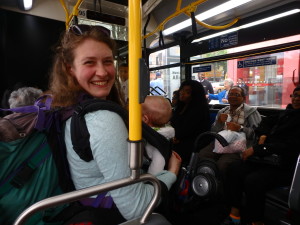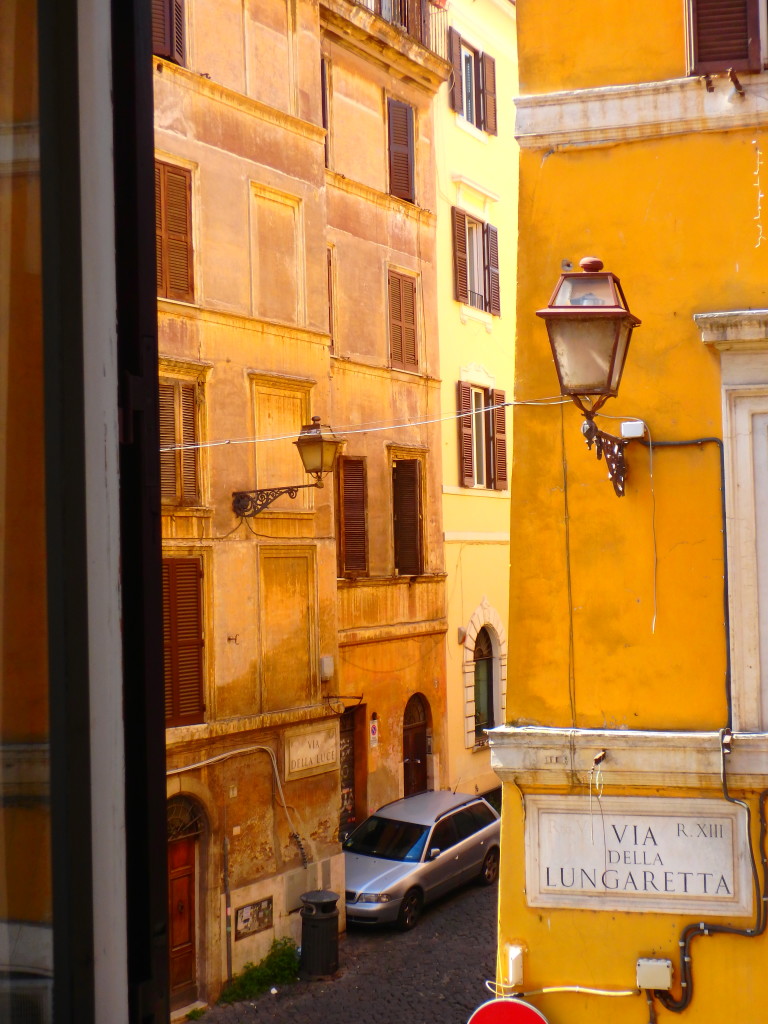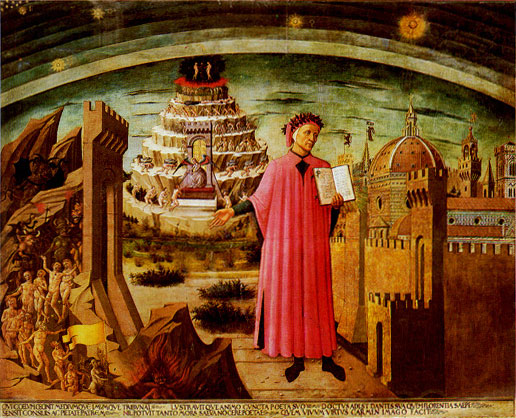
The Q10 bus in Queens to the airport. Here we go!
We expected trouble when we boarded the plane with our four-month-old twins. It was their first flight, a nine-hour transatlantic redeye to Rome. It seemed so obvious that it would be a miserable trip that my boss had given us a travel gift: a pair of talismans with a glass depiction of an eye, to ward off the malocchio. “People are going to be giving you such looks,” she said, “getting on the plane with twins. Everyone’s going to be saying, ‘Please please don’t be sitting anywhere near me.’”
This ended up being precisely the opposite of the truth. We were given terrible seats – crammed in the back, on either side of an aisle, hence not even actually next to one another, with people passing through the aisle and hitting the kids’ heads all night long -but we were surrounded by Italians – a group of eleven Sicilians flying back to Italy after a month in America. They considered it the great blessing of God that they were seated next to such “bellissimi bambini.” “Davvero! Sono gemelli! Che bello! Complimenti! Sei fortunato!” and on and on. They held them; they played with them; they entertained them as no one had ever entertained them before. They were screaming with laughter – all of them, twins and Italians. I learned all kinds of things about how to entertain them – the materfamilias had a great trick I’ve since used, of saying “a-CHOO!” at them, faking a sneeze, which the kids found the single funniest thing that had ever been done in human history, a pure piece of the divine joy. I’ve been doing it for days afterwards and it just works and works and works. This part of their childhood will be over when it stops working, I suppose.
Meanwhile I had a serious conversation with another Italian, a Milanese, in the row ahead of me, about how special Rome was. He agreed it was unique and amazing. Something then came up regarding Italian history, and I decided to ask him what the hell all those street names in Rome actually meant – Via Venti Settembre, Via Venti-Quattro Maggio, Via Quattro Novembre – we expats always used to make fun of these names, which seemed such silly names for roads, but we never even really knew what we were making fun of. He began by proclaiming that Venti Settembre was the date of the freeing of the city from the Nazis, “dagli Americani” – but then he began to hesitate. He asked a man three rows away – “Lui e molto intelligente” – but got no good answer to the question, and soon five or six men – all men – were in a spirited discussion about the significance of those dates. No conclusion was reached, though many plausible theories were hypothesized.
It continued like this. In short, the flight was delightful, because it was full of Italians. The problems all came from the airline itself. The seat was atrociously small for a man of my size; there was no room in any of the overhead compartments for baggage, so we had our carryon bags at our feet (they did not fit under the seat in front of us); the flight was absolutely packed and they had made no special accommodation for our two lapchildren (often a bulkhead seat is reserved for travellers with young children, but not in this case). Nevertheless the children were delightful, quiet and playful and in good cheer the entire time except for one incident.
About two-thirds of the way through the flight, when it was three in the morning Rome time and the lights in the cabin were all down, I was walking through the aisle with Mary, when, right in front of us, a man began shaking violently and foaming at the mouth. His wife grabbed him and started shouting, “Chris! Chris! Are you all right? Chris! Don’t stop breathing!” His body began going stiff. Immediately a rustle of panic went through the entire crowd; people got up from their seats to look, people started asking each other what was going on, et cetera – it was not loud, but it was certainly a commotion. Mary immediately turned to me and threw her mouth open and began crying, which increased the general sense of confusion. I took Mary out of the situation immediately, right to the very back of the plane, and going up to a flight attendant told her that the man in that seat where the commotion was appeared to be having a seizure. Doctors were called, and it turned out to be only a seizure, which was good; I had feared it could be something like a heart attack as well. The man was restrained for awhile, and the fit passed; he was fine when we got off the plane three hours later in Rome.
Meanwhile it took Mary a good hour to calm down afterwards, and I was impressed at how these waves of emotion can pass through crowds, and how completely tuned in to them Mary – in particular – was. John had been nursing at the time, and Catherine said he noticed the commotion but kept nursing. Mary was closer to it, of course, but this has been a consistent difference between the two, that Mary seems to be affected by the emotional atmosphere around her more than John is. We are very much herd-animals: an alarm is raised, some kind of sound is made that is different than normal, and soon every human being within earshot is aware that something is wrong. Babies can be very terrified when they know something is wrong.
Eventually Catherine nursed Mary and all three of them fell asleep, while I could not sleep at all. I did not want to turn on my light, for fear of waking them, and I could neither read nor write in the darkness; so I just sat there and counted minutes, most unhappily. But eventually the cabin lights came in; the flight attendants came by with coffee and chocolate croissants; we descended into Fiumicino. The Italians all around us declared positively that ours were the best and most beautiful bambini that had ever ever been. Thinking about the flight later – the combination of human warmth and a general sense of social eventfulness – I determined we had already been in Italy for several hours.
When we were on the ground they brought out one of those rolling staircases and we walked down the steps onto the tarmac, and there they were, the umbrella-pines of the Campagna, and the low, flat, somewhat unappealing ground of Fiumicino. I will confess I had some anxiety about returning to Rome. It was a place I had fallen in love with decades ago; now I was coming back; it was like getting together with a high-school flame twenty years later, hoping for love to still be there. Looking for an apartment for us to stay in, I had been appalled at the prices – they were fully twice what they were eight years ago, and three times what they were twenty years ago. Twenty years ago we students would be eating six-dollar dinners at good restaurants every night; now the euro had joined with a massive tourist industry to align Roman prices with other European capitals (especially in summer), airbnb had turned the whole centro storico into a hotel and there were no Romans anymore, the middle of the city was now filled with Australian bars like Ned Kelly’s selling overpriced pints to drunken English college students who had turned Campo de Fiori and Trastevere into public latrines. I could go on like this, because I had seen some of the changes beginning myself, and had heard about it from many others: expats who were thinking of getting out because the city had been transformed into Cancun for the British Isles, a spring-break destination for meatheads. I had heard about the incident of the Brit who had stripped himself naked and was parading around in puris naturalibus when he was attacked and beaten by a Roman mob who had had enough of this behavior and left him for dead; apparently there had been other incidents as well.
And in addition, everyone said the city had become more expensive, more “European,” less Roman, less Italian, and so I was unsure what to expect.
We came in the doors of the airport terminal and found a vast – an unbelievably vast – line for passport control. It went so far beyond the area for passport control, we were at first unsure that was what it was. We walked all the way down its length, and then had to walk all the way back. Lines like this drive me crazy, because of course passport control can know in advance precisely how many people will be going through at any given hour, based on flight times. So lines like this at 6:30 a.m. on a weekday in perfect weather are a sign of terrible management. And we had two little babies who had just done so well on a nine-hour flight; now we were facing a multiple-hour wait just to get a passport stamp. We waited and the line barely moved. It was utterly dispiriting. And then a woman came up to us and said we had babies, we were special travellers, she pulled us out of the line and walked us past what must have been more than a thousand people and put us on a special line that had about three people on it. A smiling, barbate Italian man at passport control made all kinds of funny faces at the babies, praised them as bellissimi, told us now we had “una coppia” (a boy-girl set) so we were done. I told him we were Catholics of the old school, we were only done when nature said so, and he laughed and said that then “e ben cominciato,” he stamped all four of our passports, and we were through.
As we walked away, Catherine said, “Well, that made that a lot easier.”
“Now we have to get our bags,” I said. “Who knows how long that will take.”
We stepped into the baggage claim area, where all the fire alarms were going off. Signs were flashing INCENDIO INCENDIO INCENDIO. Absolutely no one cared. Guards with AK-47s were standing around, wearing green combat fatigues with blue feathers stuck in their caps – I am not making that up – and doing absolutely nothing, as if the alarms had always been going off, and for all I know, they always are. Needless to say, after a few minutes of it – compounded I suppose by the fact that I had not slept at all – I felt I was beginning to go crazy. We went to our baggage claim area and found that the conveyor belt was not working: bags were coming out of the outlet, but just piled up on top of each other, creating a massive jam. People were scrambling onto the jammed bags trying to sort through them, the fire alarms were going off, guards with AK-47s and blue feathers were just standing around joking with each other – my God, I thought, nothing has changed in Italy at all. I began to take off my little baby-carrier, presuming we would be there for a long time. But then Catherine saw that our bags were there – right there, at the bottom of the pile, but visible. Both of them were there, right next to each other. And then the belt lurched forward, then stopped, then lurched again, and fitfully began to move, but in the wrong way – taking the bags through a doorway and out of sight. I couldn’t move – I had a baby half-on and half-off – and Catherine lunged and grabbed both bags, including my bag which had about forty pounds of Latin dictionaries in it.
We couldn’t believe it. We were through passport control; we had our bags. We walked out of the airport – the fire alarms going off everywhere, our ears really beginning to hurt. Catherine began wondering what this was doing to our children’s ears. We went to the train station, alarms blazing. Minor chaos – there was a ticket office, a bar, a private ticket agency, another private agency, and a newsstand, and every single one of them had big signs in English saying they sold train tickets there. Every one except the actual ticket office, that is. I smelled a scam. We got on line at the ticket office, but the line did not move at all. I went to a ticket machine while Catherine waited; they only took cards, not cash, but did not take my card (I tried two machines). Catherine had still gone nowhere. I realized we would miss the train. So I went to the newsstand, bought the tickets at their face value, we convalidated the tickets, and then we got on the train.
We were bound for Rome. And I could tell already it was going to be everything it ever was.





A Tale of Home Birth, Part 3 (of 3).
06-Mar-16And now our children were safely born, we looked around us. The midwives were cleaning up. The children’s water had not broken until they were being delivered, and for our daughter that meant right on the bed. The amniotic fluid was mixed with blood and formed a pool in the center of the bed where Catherine lay. The midwives just used a bowl and scooped it out, putting it all into larger bowls we had provided. It amazes me to say this, but there was not a drop of any kind of stain on anything when the midwives left. We had used our good sheets which we had brought from New York – we don’t really have many possessions, and so we use the ones we have – and they were in perfect condition. The midwives had all along been placing mats and moving Catherine around to make sure this would happen, but it had happened so unobtrusively that I hadn’t even noticed it going on. The sheets got more stains the day after the birth than the day of.
We were exhausted, but also filled with a nervous, joyous energy – how could we have slept at such a moment? – And so I called Catherine’s family, and invited them over. It seemed like they arrived in a flash – but time had already begun to change, and move more quickly – and since she has a large family, all of a sudden the house downstairs was full of bustle. Mom and Dad were there, and five sisters, and one sister’s fiance, and two grandmothers, and an aunt, and a cousin, and some people I didn’t know but they were welcome too. They were cooking, they were talking, they were opening bottles of champagne. By ones and twos they came up to visit Catherine and the two new little people. They set up a big table downstairs – our little dining-table seated only four – and were eating, and were happy, and the babies were brought downstairs and slept in their arms. Simply to have someone cook us a meal in that moment was a sublime act of kindness – Catherine in particular was hungry – but there was more to it than that. I loved seeing my children this way – surrounded by people who loved them. I loved the life of it – the wild, crazy, vitality of it. When the children’s grandmother and great-grandmother arrived – people were arriving by carloads – I was carrying out a bucket of blood to dump onto the compost pile. While the wine was flowing and people were laughing and picking at their plates downstairs, there were still bloody rags in waste baskets upstairs – I had stopped the midwives from cleaning out some things, so I could sort things out for the compost – and the large, bipartite fused placenta which had fed the children for months was sitting in a bowl. Some other bloody bowls sat in a cold room upstairs, to be brought to the kitchen later and washed.
I realized even then, in my relishing of the crazy vital humanity of it, how I had been transformed. All during Catherine’s pregnancy, I had expressed some skepticism about fathers who were overly involved in the actual birth. What did I know about childbirth? And how much knowledge could I really acquire? It would always be something I could only observe, not really know inside me. I thought the man’s place, when it came to birth, was downstairs with his whiskey and cigars. And to tell the truth, I was brave about many things, but things medical and bodily were not among them. In seventh grade – I still remember it vividly – we watched in science class a video of open-heart surgery and I had to leave the room, I got so sick seeing it. It was there for the first time that I got the strange feeling that I always get when I get queasy – and it is only medical things that do this to me – I feel the skin at my elbows is too tight, and they feel weird and weak, as if the marrow is about to flow out of them and onto the floor. Scenes of torture in movies, blood in real life, dissecting lab animals, and people discussing their surgeries, all produce this sensation in me. When I’ve had blood taken – even just the small amounts required for blood tests – I’ve always felt faint, and twice I’ve passed out. When I heard friends both male and female talking about birth – the blood, the flesh tearing, the pain – I’ve always felt my place would be in the next room, pacing. Otherwise I would just faint right away.
And yet here I was, carrying this bucket of blood and amniotic fluid through the kitchen where dinner was cooking, and out to the compost bin, after my wife had actually given birth right on top of my body, and I was doing it all blithely, joyfully, without even batting an eyelash – something had changed. I could feel it: I could feel that my understanding of what it meant to be human had altered. People often think that people have a hard time being religious, or being spiritual, but I think for most that is the opposite of the truth. It is easy to conceive of yourself as a spirit, and to think of the flesh as really just a series of indignities and obstacles and uncleanliness. It is much harder to be human: to reconcile yourself to having and being a body, to reconcile yourself to the fact that the stuff flowing through your veins, the minute it is delivered of your little boundaries, belongs on a compost heap: with the ends of the carrots and the paper towels and the unpopped popcorn kernels. It’s not a very dignified place in the universe, it seems. The body is so distressingly weak – just a thin bag of water constantly in danger of being punctured – that it is hard to relate it to this proud thing that I am. You don’t want to see your blood spilling into the gutter, or getting turned into fertilizer – I’d always rathered see my blood get absorbed by little medical gauze pads, thrown into one of those “bio-waste” receptacles that make it seem like our bits and pieces are radioactive and dangerous and important, and be “properly disposed of” – whatever that means. It wasn’t me, it was biowaste – I was a spirit, not some quivering mass of blood and guts. Even to think of the inside of a body was disgusting to me. But not anymore. Now I felt different – I felt my blood belonged to the soil, and the soil belonged in my blood – I felt far more part of things than I had before – my body included. In that house food was coming in, and blood was coming out – of course. Why not? Wasn’t the blood just food in a different form, transmuted by the processes of digestion and blood production? The upstairs still looked like a crime scene – the bloody rags, the lump of placental flesh in a bowl – while the people feasted and rejoiced downstairs. This too felt right. If I were just looking at it, it might seem crazy. But there was more going on than that. I was looking at it, but I was also looking from it. It was my flesh and blood that had just been born out of that woman; it was my flesh and blood that was to be fed from those cookpots in the kitchen. When you look from reality, rather than just at it, you see in an entirely different way.
Over the next few days, I would see people hold my babies, or change their diapers, and I could see my old discomfort with the body in some of them. A baby was weird and alien, fragile and breakable to some – and I saw that, and recognized that I had been like that. But other people were different – a baby sat naturally in their arms, as if it were an extension of their own body – which, of course, it really was. Some people found the whole business of changing a diaper, and having to clean someone else’s genitals and posterior just a little bit – uncomfortable. But for others it was no more trouble than it would be to bring the carrots in from the garden and clean them. And I had now become one of the latter group. I had seen birth – I had really seen blood and sweat and tears, and piss and poop and amniotic fluid and just about everything else. A woman had in fact given birth right in my arms, while I held her up – now I was going to be put off by changing a diaper? I felt prepared for anything now.
This may well be a universal experience – it would be hard for me to say. Birth is so private in our society, and it’s not that much talked about to begin with; and new parents are too busy and exhausted to write very much about the experience; and as time goes by the freshness of the impressions fades, and the lessons are internalized and are hard to put into words. But it is definitely the case, I think, that parents do have an altered relationship with the body, one which is far more intimate and less standoffish. For me it was an obvious transition because it all happened at home, in the room where I slept and in the kitchen where I cooked. I really could not have imagined myself before the birth being comfortable with leaving a bloody bowl in the room next door – “ah, we’ll get to it in the morning” – or sorting through blood-stained paper towels to see what should get composted. And yet I was. I most definitely was. And I was so happy – so happy and alive.
A few days after the birth some friends were arguing that Christ did not teach, and Christianity did not imply, pacifism. I disagreed with this position, and one of them called me out on it: now that I was a father, did I not understand violence? Would I not have done anything to save my children from someone attempting to harm them? And I can say I don’t know what I would do in any given future situation, but what I felt, after the birth, was quite the opposite of any kind of homicidal protectiveness. I felt that every human life was sacred: that it was terribly, frighteningly sacred: that even a marauder who broke into my home was some woman’s son, and his mother labored over him and laughed and cried when she saw him for the first time. He too had a day when he was born, and the light came into his sacred and venerable eyes just as it came to my daughter and my son. Having seen God’s power to create, I did not wish, even for a second, to countenance the thought of destroying it. When I heard of death – a young boy washed up on a beach, a man shot by police – my thoughts were: my son, my daughter. And I do not think that I was wrong.